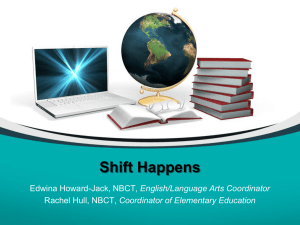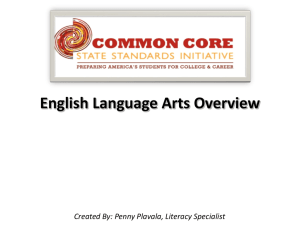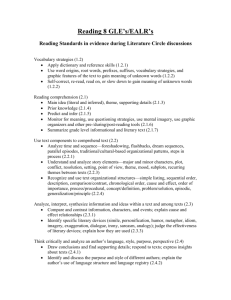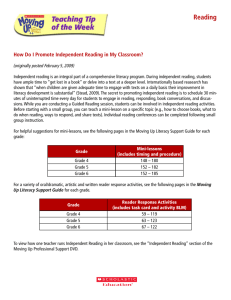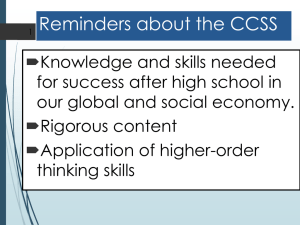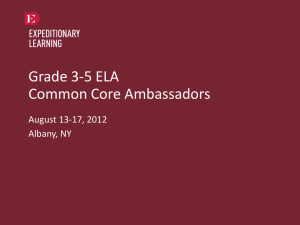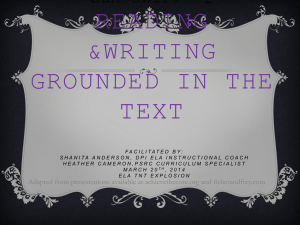HS_AugustDeepDiveintoLiteracySlides81913
advertisement
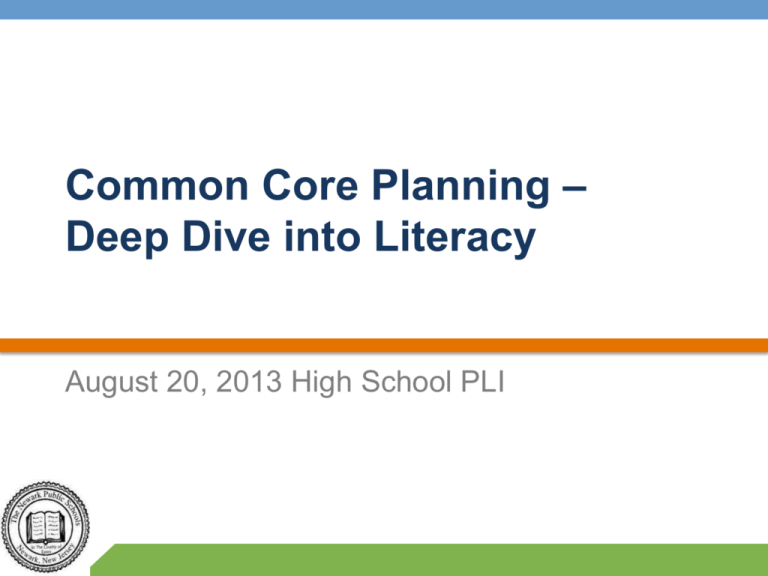
Common Core Planning – Deep Dive into Literacy August 20, 2013 High School PLI Wonderings ? On separate sheet of paper answer the following questions: 1. What teacher actions ensure shift 1 occurs? 2. What administrator actions ensures shift 1 occurs? 2 Goals – Participants will develop a common understanding of… • Implementation of Common Core State Standards’ ELA instructional shifts. • Elements of a CCSS aligned block. • How to monitor and support the implementation of Springboard, the Anthology Alignment Project, CRESST assessments etc. so that these initiatives and programs result in improved student achievement. 3 Agenda • Do Now – Pre-test & Wonderings “What teacher actions ensure shift 1 occurs?” 8:30 – 8:50 • Activity 1 – Close Read “Writing for Understanding” 8:50 –9:30 • Activity 2 – “The Road Ahead” sample lesson 9:30 – 10:00 • Activity 3 –Common Core aligned block, Parts II and III: • 10:00 – 10:30 (The Block - discussion) • 10:30 – 10:40 Break • 10:40 – 11:40 (Small Group Instruction & Independent Reading) • Activity 4 – Look Fors 11:40–12:00 4 Why Did We Change? “The Standards set requirements for English language arts (ELA) [and] for literacy in history/social studies, science, and technical subjects. …students must learn to read, write, speak, listen, and use language effectively in a variety of content areas, …the Standards specify the literacy skills and understandings required for college and career readiness in multiple disciplines.” Students, “actively seek the wide, deep, and thoughtful engagement with high-quality literary and informational texts that builds knowledge, enlarges experience, and broadens worldviews.” Response To Intervention FEW SOME Tier 1 ALL 6 ELA/Literacy: 3 Shifts 1. Building knowledge through contentrich nonfiction 2. Reading, writing, and speaking grounded in evidence from text, both literary and informational 3. Regular practice with complex text and its academic language 7 According to the Common Core, what percentage of writing prompts should be devoted to narrative, expository, and argument in grades K-5, 6-8, and 9-12? In elementary school 30% writing to argue 35% writing to explain/inform 35% narrative writing In middle school 35% writing to argue 35% writing to explain/inform 30% narrative writing In high school 40% writing to argue 40% writing to explain/inform 20% narrative writing 8 Activity 1 – Close Reading Professional reading…. 1. Readings: > Persons A & C: Read green sheet: “Writing for Understanding” > Persons B & D: Read pink sheet: “Writing for Understanding” 2. Consider what key learning(s) is the author trying to impart? As you read and recognize them please make a note for yourself, you will need to refer to your notes later. 10 Close Reading 3. Person A: Turn to your group and share the key learning(s) from your article, citing specific parts of the text that led you to your assertions. (You will have 3 minutes) 4. Person C: Did you agree with person A? if yes cite the specific claims you heard from person A & the text to affirm persons A's claims. If not, refute the specific assertions with textual evidence from your article. (You will have 3 minutes) 11 Close Reading 5. Person B it is now your turn to share your article explaining the key learning(s) and citing from your text to support your assertions. (You will have 3 minutes) 6. Person D: Did you agree with person B? if yes cite the specific claims you heard from person B & the text to affirm persons B's claims. If not, refute the specific assertions with textual evidence from your article. 12 Sharing Out 1. Please write down the group’s key learning(s) on the chart paper. (You will have 7 minutes) 2. Post your papers in the room and have a seat. 3. Choose on group’s chart to review. Are you thinking the same? Is there a “new” learning that you didn’t consider? 13 Four Elements Knowledge, and solid understanding of that knowledge Key Paradigm Shifts Writing for Understanding vs. the Writing Process The text drives what you teach A focus through which to think about and work with that knowledge and understanding A structure to develop their knowledge and understanding Grade-level control over conventions Rigor is in the reading and the task NOT the complexity of the prompt Complexity sits with the text; difficulty sits with the reader Content rich nonfiction teaches academic language What’s In and What’s Out according to the Common Core authors IN OUT 1. Daily encounters w/complex texts 1. Only some students read complex texts 2. Texts worthy of close attention 2. Reading any ‘ol text 3. Balance of literary and info texts 3. Solely literature 4. Coherent sequences of texts 4. Collection of unrelated texts 5. Mostly text-dependent questions 5. Mostly text-to-self questions 6. Mainly evidence-based analyses 6. Mainly writing without sources 7. Accent on academic vocabulary 7. Accent on literary terminology 8. Emphasis on reading & re-reading 8. Emphasis on pre-reading 9. Reading strategies (as means) 9. Reading strategies (as end goal) 10. Reading foundations (central and integrated) 10. Reading foundations (peripheral and detached) Activity 2 – Sample lesson – The Road Ahead Review – Notice – Wonder 1. Teacher instructions > Before reading > During reading 2. Culminating Tasks & Teacher Instructions 3. How is the “Writing for Understanding” philosophy manifested in the lesson? (Answer individually) 4. Turn and tell a friend at the table. 17 Take out the yellow paper and read it silently. Again, consider what key learning(s) is the author trying to impart? As you read and recognize them please make a note for yourself, you will need to refer to your notes later. 18 Activity 2 - Understanding Common Core Aligned Block Core Aligned Block Turn to a partner and share 3 things you notice. Whole Group Small Group/Independent Reading Whole Group Turn to a different partner and share 2 things you think would be new for English Language Arts, History, Social Studies, and Technical Subjects Teachers. Think about 1 misconception you will address that high school teachers will experience when viewing this document for the first time. 20 Small Group Instruction – Explicit Reading Instruction Gathering student data Forming reading/writing groups Scheduling and rotating groups Reflection and sharing Utilizing resources Classroom structure and physical setting 21 Small Group Instruction These are suggested stations that students can rotate to perform various tasks/activities. Based upon enrollment, teachers will determine the number of stations to establish in their classrooms. Group A: Teacher led group (Small group) ( Rereading selection, responding to text-dependent questions, Comprehension vocabulary…) Group B: Independent Reading (Document pages read daily; complete reading response weekly) Group C: Project-based Task (Related to main topic of reading) Fluency Specific reading strategies Group D: Vocabulary (Skill work emphasizing usage in context) Group E: Writing Text-dependent Questions Culminating Tasks Additional Tasks Group F: Research (Optional) 22 Read the Independent Reading Packet 1. Consider the protocols and procedures the packet requires teachers to establish? 2. As a group write them down on the blue paper on your tables.(You will have 7 minutes to complete this task.) 23 Independent Reading Management Norms Protocols Guidance for student selections Accountability Social Interactions 24 Activity 4 Strategic Planning for 2013-14 – Preparing to Implement Common Core Curricula Look Fors – When discussing lesson plans with teachers ask… How often has the teacher planned for students to reread text? How often has teacher planned for students to discuss text and cite evidence? Has teacher designed opportunities for students to gather evidence as a separate step in the process of writing? Is small group instruction occurring? What management tool is being employed? Is independent reading being required and monitored? 26 Pre-test Answers How did you do? Which questions do you still need answered? How can the Office of Curriculum be of service? 27 Schedule Overview for Next 3 weeks • August 19th: Introduction to Curriculum & Assessment in 2013-14 • August 20th: Deep Dive into Literacy • August 22nd: Teacher Evaluation in 2013-14 • August 26th: CST Evaluation & Special Education in 2013-14 • August 27th: Student Support Services in 2013-14 • August 27th & 28th: Springboard & WEX Training 28
